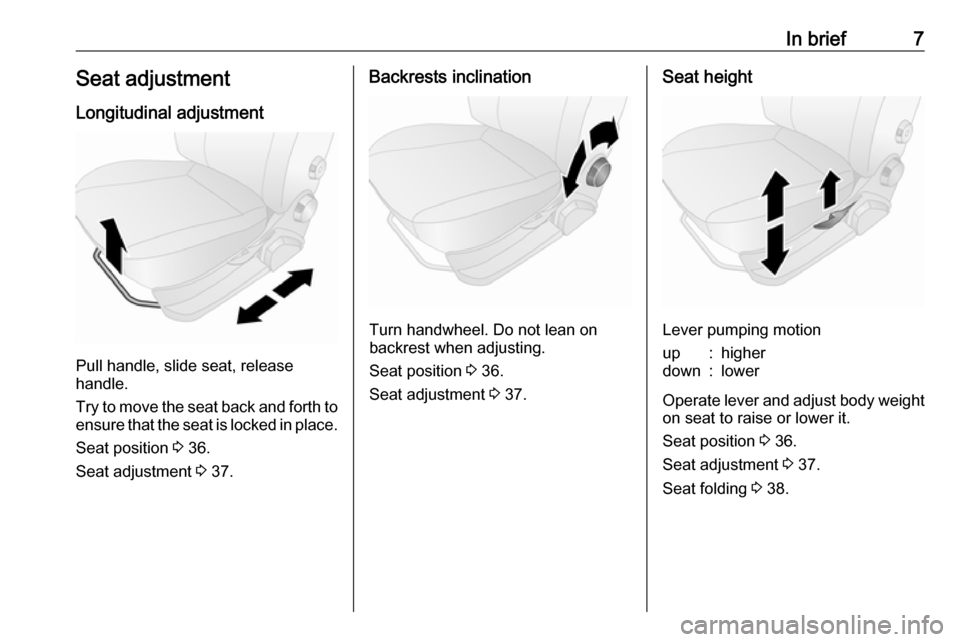weight OPEL COMBO D 2017.5 Manual user
[x] Cancel search | Manufacturer: OPEL, Model Year: 2017.5, Model line: COMBO D, Model: OPEL COMBO D 2017.5Pages: 201, PDF Size: 4.76 MB
Page 9 of 201

In brief7Seat adjustmentLongitudinal adjustment
Pull handle, slide seat, release
handle.
Try to move the seat back and forth to ensure that the seat is locked in place.
Seat position 3 36.
Seat adjustment 3 37.
Backrests inclination
Turn handwheel. Do not lean on
backrest when adjusting.
Seat position 3 36.
Seat adjustment 3 37.
Seat height
Lever pumping motion
up:higherdown:lower
Operate lever and adjust body weight
on seat to raise or lower it.
Seat position 3 36.
Seat adjustment 3 37.
Seat folding 3 38.
Page 40 of 201

38Seats, restraintsSeat backrests
Turn handwheel. Do not lean on
backrest when adjusting.
Seat height
Lever pumping motion
up:higherdown:lower
Operate lever and adjust body weight
on seat to raise or lower it.
Lumbar support
Adjust lumbar support using
handwheel to suit personal
requirements.
Rotate handwheel to increase and
decrease support.
Seat folding Folding front passenger seatDepending on version, the front
passenger seat can be folded flat to
the table position.
Page 59 of 201

Seats, restraints57Child restraint installation locations
Permissible options for fitting a child restraint system
Weight and age class
Front passenger seatSecond rowThird rowactivated airbagdeactivated airbagoutboard seatcentre seatGroup 0: up to 10 kg
or approx. 10 monthsXU 1U,
or approx. six to 12 yearsXXUUX1:When securing with a three-point seat belt, move seat to uppermost position and ensure that the seat belt runs
forwards from the upper anchorage point. Adjust seat backrest as far as necessary to a vertical position to ensure
that the belt is tight on the buckle side.<:Vehicle seat available with ISOFIX attachments. When attaching using ISOFIX, only the ISOFIX child restraint
systems permitted for the vehicle may be used.U:Universal suitability in conjunction with three-point seat belt.X:No child restraint system permitted in this weight class.
Page 60 of 201

58Seats, restraintsPermissible options for fitting an ISOFIX child restraint system
Weight classSize classFixtureOn front
passenger seatOn outboard
seats in the
second rowOn centre
seat in the
second rowOn the
seats in the
third rowGroup 0: up to 10 kg
or approx. 10 monthsEISO/R1XILXXGroup 0+: up to 13 kg
or approx. two yearsEISO/R1XILXXDISO/R2XILXXCISO/R3XIL 1)XXGroup I: 9 to 18 kg
or approx. eight months to four yearsDISO/R2XILXXCISO/R3XIL 1)XXBISO/F2XIUFXXB1ISO/F2XXIUFXXAISO/F3XIUFXX1)
The ISOFIX child seat can be installed by lifting the head restraint all the way up.IL:Suitable for particular ISOFIX restraint systems of the 'specific-vehicle', 'restricted' or 'semi-universal' categories.
The ISOFIX restraint system must be approved for the specific vehicle type.IUF:Suitable for ISOFIX forward-facing child restraint systems of universal category approved for use in this weight class.X:No ISOFIX child restraint system approved in this weight class.
Page 61 of 201

Seats, restraints59ISOFIX size class and seat deviceA – ISO/F3:forward-facing child restraint system for children of maximum size in the weight class 9 to 18 kgB – ISO/F2:forward-facing child restraint system for smaller children in the weight class 9 to 18 kgB1 – ISO/F2X:forward-facing child restraint system for smaller children in the weight class 9 to 18 kgC – ISO/R3:rear-facing child restraint system for children of maximum size in the weight class up to 18 kgD – ISO/R2:rear-facing child restraint system for smaller children in the weight class up to 18 kgE – ISO/R1:rear-facing child restraint system for young children in the weight class up to 13 kg
Page 63 of 201

Storage61Glovebox
Pull lever to open the glovebox cover.Depending on version, the glovebox
may be lockable using the ignition
key.
The glovebox should be closed whilst
driving.
Cupholders
Cupholders are located in the console between the front seats.
The cupholders can also be used to
hold the portable ashtray unit 3 75.
Front storage
Storage compartments are located in the front door pockets.
Coat hooks are located on the cabin
bulkhead (where fitted).
Overhead console
Store only lightweight items such as
paperwork or maps in the overhead
console.
Page 64 of 201

62StorageUnderseat storage
Pull the loop on the seat cushion to
gain access to the storage area.
Load compartment
Rear storage
Storage compartments are located in
the rear door pockets and in the load
compartment sidewalls.
Roof bars
Do not exceed the maximum load
(which includes the weight of the bars) of 25 kg. Always distribute the
load evenly on the roof bars. The load must not obstruct complete closure ofthe doors.
Retighten the fastening screws on the
four brackets periodically.Caution
Do not use elastic lashings, e.g.
bungee cord. We recommend the
use of webbing straps.
Roof bars are designed to be fitted in
a specific position. Proper fastening
of the roof bars cannot be guaranteed if refitted in another position.
No materials (e.g. rubber, plastic)
should be placed between the feet of
the bars and the vehicle body, to
ensure proper fastening.9 Warning
The use of roof bars may affect
steering and vehicle handling.
Removal
To remove the roof bars when not in use:
Page 70 of 201

68Storage● The load must not obstruct theoperation of the pedals, parking
brake and gear selector lever, or
hinder the freedom of movement of the driver. Do not place any
unsecured objects in the interior.
● Do not drive with an open load compartment.9Warning
Always make sure that the load in
the vehicle is securely stowed.
Otherwise objects can be thrown
around inside the vehicle and
cause personal injury or damage
to the load or vehicle.
● The payload is the difference between the permitted gross
vehicle weight (see identification
plate 3 180) and the EC kerb
weight.
To calculate the payload, enter
the data for your vehicle in the
weights table at the front of this
manual.
The EC kerb weight includes
weights for the driver (68 kg),
luggage (7 kg) and all fluids (fuel
tank 90% full).
Optional equipment and
accessories increase the kerb
weight.
● Driving with a roof load increases
the sensitivity of the vehicle to
cross-winds and has a
detrimental effect on vehicle
handling due to the vehicle's
higher centre of gravity.
Distribute the load evenly and secure it properly with retaining
straps. Adjust the tyre pressure
and vehicle speed according to
the load conditions. Check and
retighten the straps frequently.
Do not drive faster than
120 km/h.
The permissible roof load (which
includes the weight of the roof
rack) is 100 kg. The roof load is
the combined weight of the roof
rack and the load.
Page 139 of 201

Driving and operating137Terms for "natural gas " abroad:GermanErdgasEnglishCNG = Compressed
Natural GasFrenchGNV = Gaz Naturel (pour)
Véhicules - or -
CGN = carburantgaz
naturelItalianMetano (per auto)
Fuel filler cap
Only use genuine fuel filler caps.Diesel-engined vehicles have special
fuel filler caps.
Fuel cut-off system In the event of a collision of a certain
severity, the fuel system is cut-off and
the engine is switched off
automatically, for safety reasons.
Resetting the fuel cut-off system;
refer to "Fuel system messages"
3 96.
Fuel consumption - CO
2-
Emissions
The fuel consumption (combined) of
the model Opel Combo is within a
range of 7.7 to 4.1 l/100 km.
Depending on country, the fuel
consumption is displayed in km/l. In
this case, the fuel consumption
(combined) of the model Opel Combo is within a range of 13.0 to 24.3 km/l.
The CO 2 emission (combined) is
within a range of 179 to 120 g/km.
For the values specific to your
vehicle, refer to the EEC Certificate of
Conformity provided with your vehicle or other national registration
documents.
General information The official fuel consumption and
specific CO 2 emission figures quoted
relate to the EU base model with
standard equipment.
Fuel consumption data and CO 2
emission data are determined
according to regulation R (EC)
No. 715/2007 (in the latest applicableversion), taking into consideration the
vehicle weight in running order, as specified by the regulation.
The figures are provided only for the
purpose of comparison between
different vehicle variants and must
not be taken as a guarantee for the
actual fuel consumption of a
particular vehicle.
Additional equipment may result in
slightly higher results than the stated
fuel consumption and CO 2 figures.
Furthermore, fuel consumption is dependent on personal driving style
as well as road and traffic conditions.
Natural gas
The fuel consumption information
was obtained using reference fuel
G20 (methane proportion
99 - 100 mol%) under prescribed
driving conditions. When using
natural gas with a lower proportion of
methane, the fuel consumption can
differ from the specified values.
Page 140 of 201

138Driving and operatingTrailer hitch
General information
Only use towing equipment that has
been approved for your vehicle.
Vehicles with natural gas engine may
require special towing equipment.
Entrust retrofitting of towing
equipment to a workshop. It may be
necessary to make changes that
affect the cooling system, heat
shields or other equipment.
Fitting of towing equipment could
cover the opening of the towing eye.
If this is the case use the coupling ball bar for towing. Always keep the
coupling ball bar in the vehicle.
Driving characteristics and towing tips
Before attaching a trailer, lubricate the coupling ball. However, do not do so if a stabiliser, which acts on the
coupling ball, is being used to reduce
snaking movements.For trailers with low driving stability
and caravan trailers with a permitted
gross vehicle weight of more than
1300 kg the use of a stabiliser is
strongly recommended when driving
above 80 km/h.
If the trailer starts snaking, drive more slowly, do not attempt to correct the
steering and brake sharply if
necessary.
When driving downhill, drive in the
same gear as if driving uphill and
drive at a similar speed.
Adjust tyre pressure to the value
specified for full load 3 190.
Trailer towing
Trailer loads The permissible trailer loads are
vehicle and engine-dependent
maximum values which must not be
exceeded. The actual trailer load is the difference between the actual
gross weight of the trailer and the
actual coupling socket load with the
trailer coupled.The permissible trailer loads are
specified in the vehicle documents. In general, they are valid for gradients
up to max. 12%.
The permitted trailer load applies up to the specified incline and up to an
altitude of 1000 metres above sea
level. Since engine power decreases
as altitude increases due to the air
becoming thinner, therefore reducing
climbing ability, the permissible gross
train weight also decreases by 10%
for every 1000 metres of additional
altitude. The gross train weight does
not have to be reduced when driving
on roads with slight inclines (less than
8%, e.g. motorways).
The permissible gross train weight
must not be exceeded. This weight is specified on the identification plate
3 180.
Vertical coupling load
The vertical coupling load is the load
exerted by the trailer on the coupling
ball. It can be varied by changing the
weight distribution when loading the
trailer.